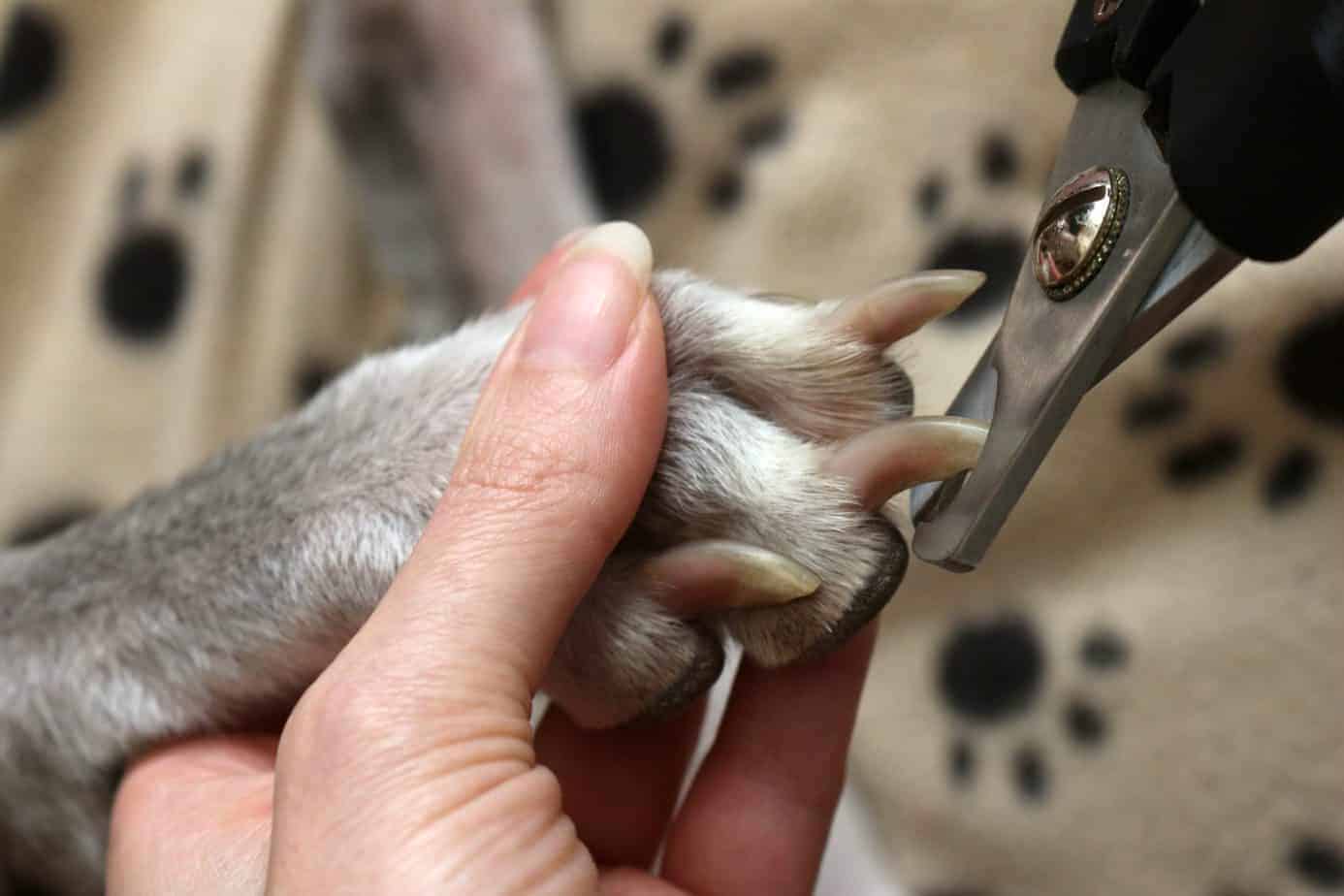Learning how to trim dog nails can be a nerve wracking time. This is probably the one hygiene requirement that made me the most nervous and scared because of just how many horror stories I’ve heard! But once I learned how to trim dog nails easily, both my dog and I have stopped being so nervous and started to actually look forward to getting it done!

In this post, I’m going to take you through everything I learned about how to trim dog nails so you can put it into practice. I’ll tell you just how important it is to make this a regular habit, how to expose your dog to the whole thing so they get comfortable and the steps to either trimming or grinding dog nails easily.
Why Trim Dog Nails?
Regularly cutting your dog’s nails is more than just a cosmetic adventure – it’s a necessary one for their health. Unhealthy nails are painful and can trigger irreversible damage in dogs over time. Long nails can reduce traction for a dog and can cause what’s called a splayed foot, which can deform feet and injure tendons over a long period of time. The pressure of the nail hitting the ground and putting force on the foot will cause this injury and is quite painful for your pooch.

When to Trim Dog Nails
A good rule of thumb to follow for how often you need to trim your dog’s nails is as soon as they start touching the ground. Similar to human nails, the nail will begin to curve and grow inward which become incredibly uncomfortable and painful for your pooch. If you hear your dog’s nails tapping on the floor of your house or on the ground, you can take that as your sign to trim those nails!

It’s important to note that there are some dog breeds who naturally wear down their nails on walks (my dog is like this) but you still have to keep an eye on the nails to make sure they don’t grow too long without you being aware! There is also a nail called the “dewclaw” (sort of like a dog thumb) which never touches the ground because of where it’s located. This nail needs to be trimmed regularly to avoid getting caught on things and tearing.
Nail Trimming Tools
There are a variety of options available to you when you are looking at trimming your dog’s nails. For those most part, you are going to have one of two type of trimming tools – actual trimmers or grinders. You can use whichever one you are more comfortable with (in my experience, the trimmers have been what my dog prefers).
Another important thing to have in supply is Styptic or clotting powder. On the off chance that you do cut the quick of the dog’s nail, you want to have something to stop the bleeding.
Exposing Your Dog
If you’ve never trimmed your dog’s nails before, you should take the time to get them used to the entire experience before just throwing them into the deep end. Be patient and offer lots of praise while you are exposing them to the tools to help them feel comfortable and confident.
Start by letting them just sniff the clippers and praising them when they do that. Then, you can progress to touching their paws gently with the clippers and praising them. Once they are comfortable with the clippers touching them, practice squeezing the clippers to help your pooch get used to the sound (but don’t actually trim a nail yet). Gradually, begin to trim one nail and praise your pup, then move up to two nails the next day, three nails the day after that, and so on.
Remember, always praise them and, if they start to get uncomfortable, go back to the previous step and re-introduce them. You never want to force your dog to deal with something they are scared of or they are going to have that connection for a long time.

How to Trim Dog Nails Step-by-Step
Okay, let’s get into it! To learn how to trim dog nails, follow the steps below:
Pick up paw firmly – It’s important to have a good grasp on the paw to ensure don’t allow your dog to easily move it around while you are trying to trim the nail. By pressing your thumb on the pad of a toe and your forefinger on the top of the toe it will expose the toenail more easily.
Position the clippers – Once you’ve exposed the nail, position the clippers over the nail. You don’t want to go too far down as there is a quick in the nail which, if cut, will begin to bleed a lot! As a rule of thumb, avoid clipping past the curve of the nail.

Clip – Once you’ve got the clippers in position, you can push down on the clippers and snip off the end of the toenail.
Praise and reward – As you go, continue to praise your dog for their calm behavior and reward them ongoing. Because it’s very easy for a dog to have a negative experience with anil trimming, you want to be patient and work with your dog as you progress.
Note – it’s often easier to introduce your dog to nail trimming if you have someone else there to help you. They can gently restrain your dog, distract them with treats (peanut butter is a favorite in this house) while you are cutting the nails.
What If You Cut the Nail Too Short?
We’ve all done it as much as we’ve tried to avoid it! If you end up cutting into your dog’s quick, the first thing to do is stay calm! This is why you want to have styptic powder or clotting powder on hand to dip the nail into. When you dip the nail into the powder, it coagulates the blood and stops the flow, creating a clot at the bottom of the vessel. This also helps prevent any bacteria from entering the blood vessel.
Be aware that your dog is likely going to yelp and try to get away if you do accidentally cut the quick. Try to avoid them running all over the place because the blood vessel will bleed quite a bit until you get the clotting powder on it. And while you don’t want your dog to feel restrained when they are hurt, you likely also don’t want them running around the house bleeding everywhere!

If you cannot get the bleeding to stop, call your vet right away.
Start Early
The earlier you can expose your dog to the nail trimming process, the more they are going to get comfortable and see it as a part of a normal day. Nail trimming is just as important for puppies as it is for adult dogs so starting young is going to help you and your dog have a much easier time getting used to the entire process.
And, as we always say, an obedient dog makes life much easier! If your dog is well trained, they will have more trust in you when you ask them to perform certain commands. If you feel your dog could use some extra obedience training, I highly recommend you check out Brain Training for Dogs where they can learn obedience commands, build their confidence, and develop a closer relationship with you (which comes in handy when you are trying to avoid cutting their nails too short!).
For more information on Brain Training for Dogs, check out my honest review of the entire program. I used this program with my own dog and was surprised at how much it impacted her confidence and how well behaved she has become!
*Disclosure: I only recommend products I would use myself and all opinions expressed here are our own. This post may contain affiliate links that at no additional cost to you, I may earn a small commission.










